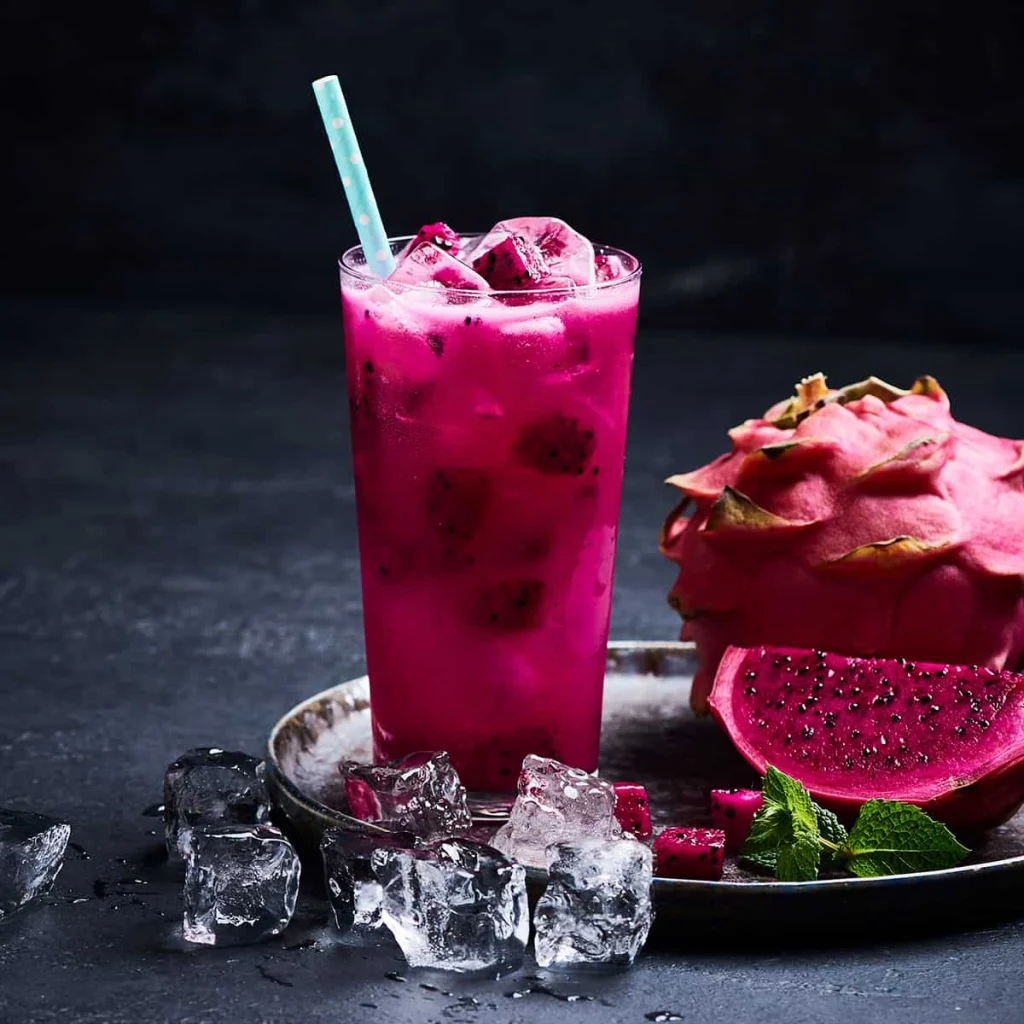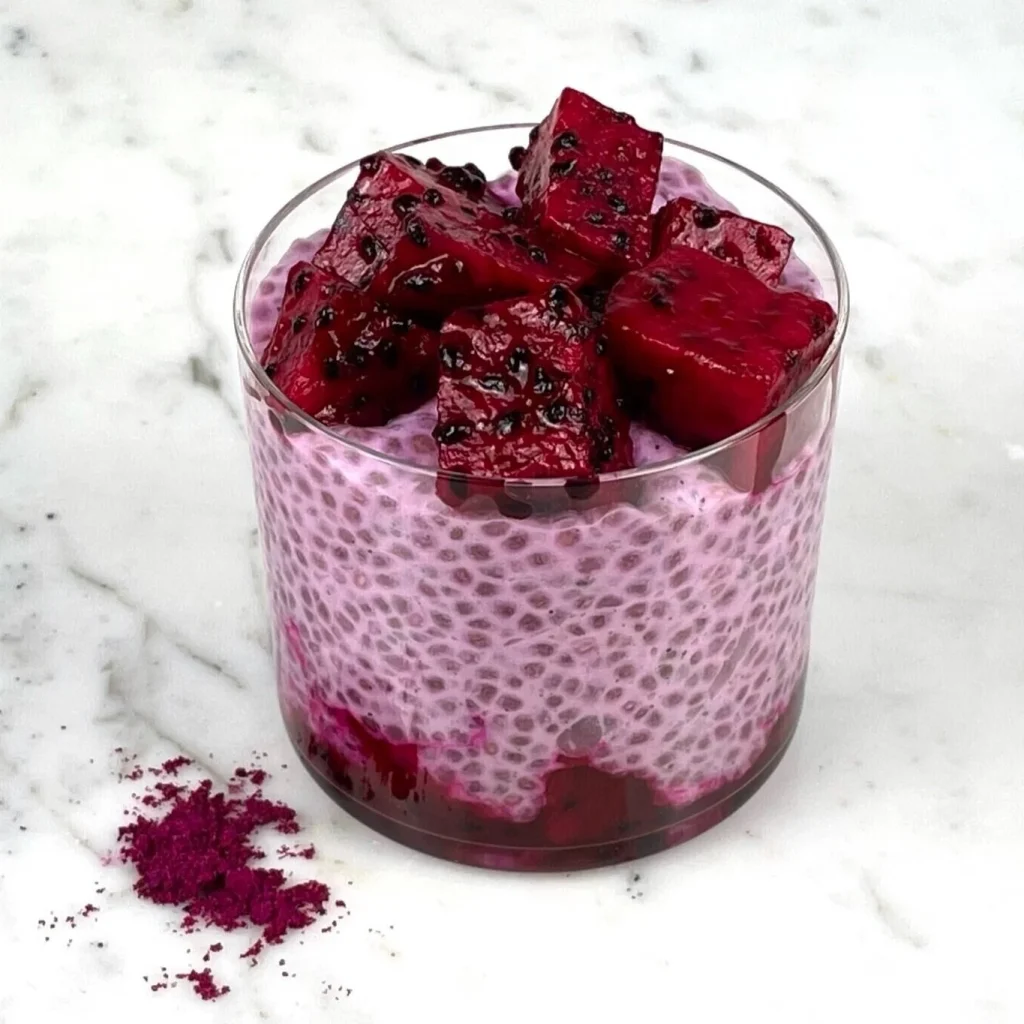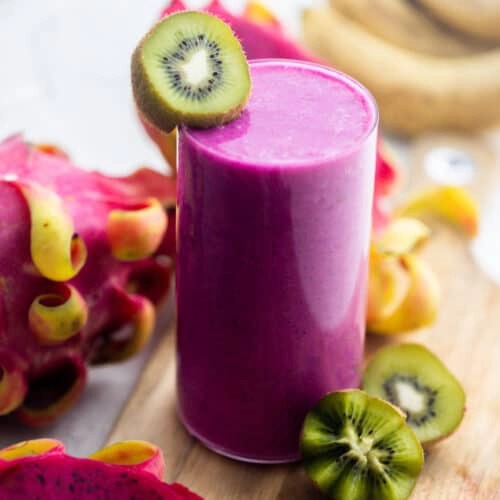Written by Carolina Machado
Medically reviewed by Grisel Aranzabe (Nutritionist, low-FODMAP approach & Human Microbiota Specialist)
Dragon fruit, also known as pitaya or pitahaya, amazes with its surreal shapes and vibrant colors—yellow, white, purple, or red. Its spiky, otherworldly appearance is only the beginning. Inside, the fruit offers a mildly sweet, refreshing taste often described as a blend of kiwi, watermelon, and pear. Each oval-shaped fruit measures 4 to 6 inches long and delivers a distinctly tropical experience.
In the U.S., the most commonly found variety is the white-fleshed dragon fruit, recognizable by its pink skin and a creamy white interior speckled with black seeds. Red-fleshed varieties are also available in specialty or international markets.
Dragon Fruit Flowers: A Rare Nocturnal Beauty
Dragon fruit blooms at night, revealing aromatic, white flowers that are usually pollinated by bats and other nocturnal creatures. These beautiful blossoms close by dawn, making the experience of seeing them feel like catching a rare natural phenomenon. If you have access to a dragon fruit plant, don’t miss the chance to witness this nocturnal spectacle.
Although its appearance might remind you of something out of a medieval fantasy bestiary, dragon fruit is a very real, ancient fruit—one that has been enjoyed for centuries and continues to thrive around the world today.
Where Does Dragon Fruit Come From?
Dragon fruit is a tropical climbing cactus native to Southern Mexico and Central America, where it has grown wild for centuries. It was cultivated by the Aztecs and Mayans as a food source, and valued for its spiritual and medicinal uses. In the early 1800s, the fruit was introduced to Southeast Asia, where it was initially enjoyed only by the elite. Over time, it became widely cultivated, spreading throughout Asia and eventually reaching the Middle East and Australia.
Dragon Fruit Health Benefits: Nutrition and Antioxidants
Dragon fruit is packed with nutrients, and while values vary slightly between white-flesh and red-flesh varieties, both offer excellent health benefits.
The skin and flesh both contain water-soluble betacyanins, which are responsible for the intense red (dark pink/purple) color and the fruit’s antioxidant and anti-inflammatory properties.
Dragon Fruit Nutrients at a Glance
- Vitamin C
- Fiber
- Magnesium
- Potassium
- Iron
- Phosphorus
- Antioxidants
- Vitamin E
- Beta-carotene
Dragon Fruit Potential Health Benefits
- Strengthens the immune system
- Supports digestion and gut health
- Helps regulate hydration and fluid balance
- Supports bone strength and dental health
- May help improve eyesight
- Aids in healing wounds
- May help prevent colon cancer and manage diabetes
- Can lower cholesterol and blood pressure
- The peel and pulp may help inhibit the growth of certain cancer cells
Always consult a medical professional before using dragon fruit for therapeutic or medicinal purposes.
Dragon Fruit for Energy and Muscle Recovery
Red dragon fruit is rich in antioxidants—a key factor for energy production and muscle recovery. When combined with regular physical activity, it may help maintain red blood cell and hemoglobin levels, improving stamina and performance.
How to Use Dragon Fruit
Dragon fruit’s taste is mildly sweet, slightly acidic, and earthy, combined with nutty hints from the seeds. The deeper the pink hue of the flesh, the sweeter the taste tends to be. Above all, it provides a cool, refreshing effect on the body—perfect for hot days or post-workout rehydration.
How to Eat Dragon Fruit
- Scoop out the flesh and eat it raw
- Add it to smoothies, fruit salads, or yogurt bowls
- Blend it with ice and lime juice for a refreshing drink
- Use it to make jams or desserts
- Try unopened flower buds cooked like a vegetable
- Use red-flesh juice as a natural food coloring
- And yes—red pitaya wine exists! This fermented drink is popular in some Asian countries, particularly China—but it can also be found at specialty wineries in the U.S., and there are homemade recipes online
Conservation Tip: Keep uncut dragon fruit at room temperature for a few days, or refrigerate it for longer freshness.
Easy Dragon Fruit Recipes
1. Dragon Fruit Refreshing Lemonade

Ingredients
- 1 peeled dragon fruit
- Juice from 5–6 lemons
- 5 cups of water
- Sugar or syrup (optional)
Preparation
Mix everything together and enjoy. Serve chilled over ice for extra refreshment.
2. Dragon Fruit Chia Seed Pudding

Ingredients
- 1/2 peeled dragon fruit
- 1/2 cup plant-based milk or milk of your choice
- 2 tbsp chia seeds
Preparation
Blend ingredients. Cover and refrigerate for at least 2 hours or overnight. Enjoy as a nutritious breakfast or snack. It’s naturally sweet, so no extra sugar is necessary. For a delicious layered treat, serve with coconut yogurt, granola, and fresh fruit.
3. Tropical Smoothie Blend

Ingredients
- 1/2 peeled dragon fruit
- 1 frozen banana
- 1 kiwi
- 3/4 cup coconut milk
- 1/2 cup lemon juice
Preparation
Blend until smooth. Add more milk or water as needed to reach your preferred texture. Ready to enjoy!
How to Grow Dragon Fruit at Home
Are you thinking of growing your own? Here are a few simple things to keep in mind:

- It’s a climbing cactus, so it needs a structure or trellis for support
- Thrives in both dry and humid environments
- Requires little water but lots of sunlight
- The blossoms bloom for just one evening each year; fruit begins to form shortly after
- A healthy plant can consistently produce fruit for 20 to 30 years
If you’re ready to give it a try, check out guides from specialists, such as How to Grow Dragon Fruit Magazine – A Step-by-Step Handbook.
Where to Buy Dragon Fruit
This striking fruit is available at many grocery stores, especially those with organic or international sections. You can also find it through online retailers, farmers’ markets, or at local farms in states like California, Florida, and Hawaii.
Dragon Fruit Deserves a Place in Your Diet
Dragon fruit isn’t just exotic-looking—it’s deeply nourishing, refreshingly easy to enjoy, and full of natural goodness. Whether you’re slicing it fresh, blending it into smoothies, or boosting your recovery after a workout, this tropical superfruit is a delicious way to bring color, flavor, and nutrition to everyday meals.




